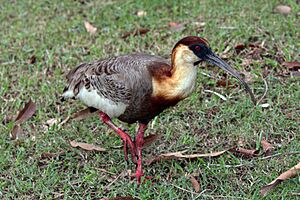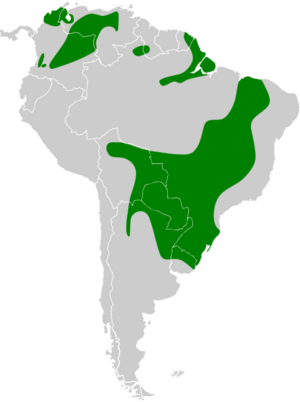Buff-necked ibis facts for kids
Quick facts for kids Buff-necked ibis |
|
|---|---|
 |
|
| in Pantanal, Brazil | |
| Conservation status | |
| Scientific classification | |
 |
The buff-necked ibis (Theristicus caudatus), also called the white-throated ibis, is a fairly large bird. It's a type of ibis, which are wading birds with long, curved bills. You can find it in open areas across eastern and northern South America. It looks a lot like the black-faced ibis, but that bird lives in colder places. The buff-necked ibis also has a dark grey lower chest and bright white patches on its wings.
Contents
About the Buff-necked Ibis
Scientists use a system called taxonomy to name and group living things. This helps us understand how different species are related.
How it Got its Name
The buff-necked ibis was first described by a French scientist named Georges-Louis Leclerc, Comte de Buffon in 1781. He wrote about it in his book Histoire Naturelle des Oiseaux. The bird was seen in Cayenne, French Guiana.
Later, in 1783, a Dutch naturalist named Pieter Boddaert gave it its scientific name, Scolopax caudatus. Today, it's placed in a group called Theristicus. This name comes from an old Greek word meaning "of reaping," like harvesting crops. The second part of its name, caudatus, is Latin for "tailed."
Different Kinds of Buff-necked Ibis
There are two main types, or subspecies, of the buff-necked ibis:
- T. c. caudatus: This type lives in northern South America. You can find it in countries like Colombia, Venezuela, and parts of Brazil.
- T. c. hyperorius: This type lives further south. It's found in places like eastern Bolivia, southern Brazil, and northern Argentina.
What the Buff-necked Ibis Looks Like
This ibis is about 75 centimetres (30 in) long, which is almost as tall as a 12-year-old!
Colors and Features
- Its neck is a light, creamy color, which is where it gets the "buff-necked" part of its name.
- Its back is grey.
- Its belly and flight feathers (the long feathers on its wings used for flying) are black.
- It has a large white patch on its wings. When it flies, this white patch looks like a wide band. It separates the black flight feathers from the grey feathers closer to its body.
- Its bill (beak) and the skin around its eyes are dark, almost black.
- Its legs are red.
When it flies, its relatively short legs don't stick out past its tail. This is different from some other ibis species.
Where the Buff-necked Ibis Lives
The buff-necked ibis lives in many different open places. These include fields, marshes, savannas, and grasslands.
Its Home Range
There are two main groups of these birds:
- The northern group (T. c. caudatus) lives across northern and central South America. This includes Colombia, Venezuela, the Guianas, and Brazil.
- The southern group (T. c. hyperorius) lives in south-central South America. This includes southern Brazil, eastern and northern Bolivia, Paraguay, Uruguay, and northern Argentina.
They mostly live in warm, tropical, and subtropical lowlands. They usually stay in one area, but sometimes they might move locally. Very rarely, one might visit Panama.
Its Conservation Status
The buff-necked ibis is doing well! It lives in a very large area. Scientists estimate there are between 25,000 and 100,000 of these birds. Because of its large population and wide range, it is listed as "Least Concern" on the IUCN Red List of Threatened Species. This means it is not currently at risk of extinction.
How the Buff-necked Ibis Behaves
The buff-necked ibis is always looking for food in soft ground.
What it Eats
Its diet mainly includes:
- Insects
- Spiders
- Frogs
- Reptiles
- Snails
- Other small invertebrates (animals without backbones)
- Small mammals
Nesting Habits
When it's time to lay eggs, the female ibis usually lays two to four eggs. She builds a platform nest using twigs and branches. These nests are usually found high up in a tree.



